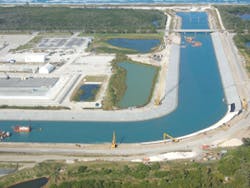Project Profile: Underwater Expertise
The ability to perform dam reconstruction underwater is of great benefit to owners, allowing them to avoid facility shutdowns and construction of dewatering systems. The training and experience of commercial divers combined with the advancement in such materials as precast articulated concrete block has led to a great increase in “wet” construction and significant cost savings.
Quality always begins and ends with the staff-in this case the divers. There are thousands of scuba divers in this country; most are considered recreational divers. They take a certification course that includes classroom work, pool training, a written exam, and finally a “checkout” dive in open water. The whole process can be accomplished in a few weekends. While great as training for Caribbean adventures, this by no means prepares the diver for dam construction.
A commercial diver is a very different individual. Training, both in the classroom and in the water, takes hundreds of hours and many months. Commercial divers must train to the point that their underwater environment becomes a comfortable place to perform construction work. Training includes working with all tools of the trade, including underwater welding, drilling, and hydraulic and compressed-air tools.
So what would a diver do underwater? Expectations include placement of formwork, pouring of concrete, welding, cutting, cleaning, and demolition-just about everything needed to repair or construct a structure out of the water.
A great example of diver expertise is the reconstruction project at the Port St. Lucie, FL, nuclear power plant operated by Florida Power & Light (FPL). The power plant generates electricity by boiling water into steam drawn from the ocean through intake canals. During the 2004 and 2005 hurricane seasons, the canals were hit hard, resulting in severe erosion to the canal embankments. To perform repairs in the dry, the plant would have to shut down. In addition, temporary cofferdams would have to be constructed for dewatering to take place. For these reasons, FPL issued a design-build proposal that mandated no plant shutdown. The winning proposal, based on best value, was that offered by Greenman-Pedersen Inc. as design engineer with its subsidiary Underwater Engineering Services Inc. (UESI) as prime contractor and Contech Construction products supplying the embankment repair material.
UESI, located in Port St. Lucie, provides commercial diving services, marine contracting, general contracting, and design-build services. UESI uses 30 divers, equipment operators, carpenters, masons, surveyors, and support staff.
Quality is a requirement of all staff, but material quality and selection is equally as important. The use of precast articulate block mats as the primary product for the repair was chosen based on the ability of the product to articulate and to maintain contact with the subgrade, the quality of the precast concrete blocks, and the ability to install the product without increasing turbidity.
Riprap was feasible, but the accuracy of underwater placement questionable, and the requirement to replenish it made the other options more appealing. The best and winning option was the use of precast articulated concrete block. These blocks are interconnected with cables in the mats, allowing flexibility for ease of placement and alignment. The precast product was placed with cranes; areas that were inaccessible by crane utilized a grout-filled fabric product.
Commercial divers were involved with every phase of the operation. They ensured that the excavation of material was completed to the proper grade. Divers then installed the geotextile filter fabric, which required anchorage because of steady channel currents. Installation of geotextile filter fabric by divers is a common repair for dams. Seepage can be dramatically reduced or eliminated by placement of the fabric. Next, the divers guided the concrete mats into place with crane signals from the divers using the communications system provided in the hardhat dive mode selected by UESI. This was a critical job to ensure proper seam alignment. Finally, divers poured special concrete with anti-washout admixtures along the underwater horizontal seams between mats.
Water temperatures in portions of the canal water reached 107°F due to the heated water from the plant. UESI upgraded its hot-water diving program with updated technologies during the four-month dive operation in hot water. Chilled water was pumped through the divers’ suits to form a cool-water barrier. The ability of the diver to work under such adverse conditions as high water temperature, current, and low visibility was critical to the project’s ultimate success.
Another FPL conventional power plant facility, located in Sanford, FL, had similar problems with its dikes. Divers installed more than 2,500 earth anchors to prevent any future movement of the mats. A major problem with dikes and dams is creation of voids through “piping.” This occurs when seepage initiates and carries fines out of the embankment until the flow starts to create large voids. Divers are the best option for locating such voids and filling them.
For the Sanford project, 750 tons of limestone pea rock was placed with the aid of divers.To reduce dive time and increase diver safety, dam rehabilitation projects have been supplementing divers with remote-operated vehicles (ROVs). ROVs can perform preliminary inspections, checking the dive area for risks, and work very well in areas with dangerous currents or polluted waters. While ROVs are great tool for preliminary dive work, it is ultimately the diver that needs to do the real work.
To determine whether a dam is in need of repair, inspections by dive personnel are recommended at regular intervals. Divers can visually detect such potential problems as scour, concrete cracking or spalling, and corrosion or wear of metal components. All of these problems can be repaired by dive crews. Working with the engineering staff allows staying ahead of problems, and understanding why problems are occurring in the first place is critical. Commercial divers can be an integral part of dam maintenance, including condition assessment, rehabilitation, and repair.


